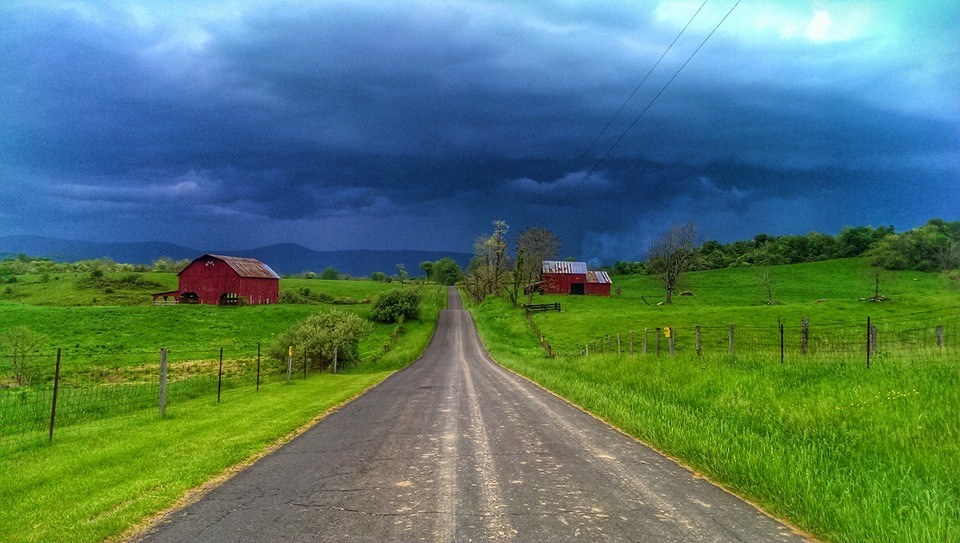By Ashley Peele

Rural Birding (CO AE Johnson-Venclik)
What is blockbusting?
This term is frequently used, but rarely explained in the context of breeding bird atlases. Simply put, blockbusting refers to the practice of surveying one or more Priority blocks over the course of several days or a weekend. Typically, these blocks do not yet have any breeding bird data and are located in rural areas with few to no local volunteers.
Why are we focusing on it?
As we enter the final two years of the VA BBA project, there are a number of regions that still have Priority blocks with little to no data. Blockbusting is one way for volunteers to help us tackle this challenge. While most Atlas volunteers may not be able to commit to finishing a series of rural blocks, blockbusting offers an opportunity to add valuable data in empty Priority blocks and significantly improve the county and even region-level survey coverage for rural areas.
Urbanization or the increasing numbers of people moving to cities, means that Atlas data is clustered around population centers. Blockbusting helps us to begin reducing the bias in our survey coverage. We need to know about those county birds too!
Is this the only way to volunteer for the Atlas now?
Nope! Traditional Atlas volunteering includes signing up to survey and complete priority blocks in your ‘home’ region. This is what many of our volunteers undertake each summer. If you are able and willing to do this type of surveying, then we encourage you to carry on. A complete view of all unassigned, incomplete priority blocks in your region, including those that didn’t make the blockbusting list, can be seen with the Atlas Block Explorer tool.
However, if you decide to help us blockbust our highest priority blocks, then this leads us to the next question…
How do I know if blockbusting is a good fit for me?
Here are few things to consider…
- Are you willing to travel away from home? Most of the Atlas priority blocks targeted for blockbusting are some distance from Virginia’s populated areas. Depending on your home base, these blocks could be anywhere from 0.5-6 hours away, so comfort with travel is important.
- Do you mind spending a few days away from home? Most blockbusters use the weekends or 2-3 weekdays to travel to their target area and survey several priority blocks. If you’re making the trip, you may as well maximize your effort while there!
- Are you interested in exploring rural Virginia? The Commonwealth has a wide range of unique and beautiful habitats. Blockbusting can introduce you to new, interesting corners of the state. Plus you may be the first Atlas volunteer to survey your chosen blocks, so your data will provide extremely important information for the area! Who knows what exciting species you may turn up in the southern Piedmont or southwestern mountains!
- Are you comfortable with roadside birding? Unless your target blocks have some public land access, you’ll likely be doing a lot of roadside birding, which consists of cruising around a block, pulling off to look and listen in fields, woodland edges, etc.
If you’re still with us, then let’s dive into the next big question.
Where should I blockbust?
All Atlas regions still have one or more priority blocks in need of additional survey time, but several are dominated by forested and agricultural landscape with lots of great habitat and few humans to get out and survey in them. Such areas are primarily located throughout southern Virginia.
To provide guidance on where to blockbust, we pooled all unassigned and incomplete priority blocks, then ranked these according to a series of criteria. The criteria included current survey data, historical data, and proximity to completed blocks. From these rankings, we produced a series of Blockbusting Target Maps to guide volunteers in choosing where to go and what blocks to focus on.

Priority rankings for unassigned and incomplete priority blocks.
This map gives you a statewide view of where targeted priority blocks are located. There are three tiers of blocks:
- Tier One (green) – Highest Priority
- Tier Two (orange) – Intermediate Priority
- Tier Three (blue) – Lowest Priority
All of these blocks need survey effort, but volunteers should start with green blocks and work down to blue, if possible. If logistics don’t allow this, then we’re happy for volunteers to report breeding bird data in any target priority blocks, especially in the southern regions of Virginia.
Note: Grey blocks indicate priority blocks that are either assigned to volunteers or completed. Priority blocks that are not pictured are those that didn’t make the high priority rankings, but are not yet completed or assigned.
Each region has its own map, which can be viewed and downloaded on our new Blockbusting webpage. Additionally, you can download a list of all targeted priority blocks organized by region on this same page (and by clicking here: VA BBA Blockbusting Priority Rankings -2019).
Upon reviewing these maps, you may still feel like you need more guidance on where to target. Reach out the area’s regional coordinator or the Atlas state coordinator with such questions (Atlas Contacts). We’re eager to help you get out into the field and surveying for breeding birds!
Blockbusting Events
This field season, the VABBA2 project will be hosting a series of blockbusting rally weekends in the southern half of Virginia. These events will be based at four different state parks. Volunteers will be organized into small groups, which will radiate out from the state parks and into surrounding priority blocks.
Rally Weekend locations and dates will be announced next week (March 13th). Volunteers will be able to register for the events at that time!

